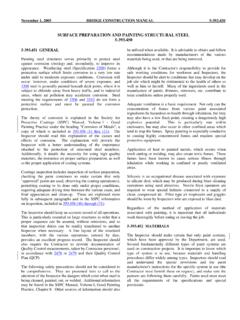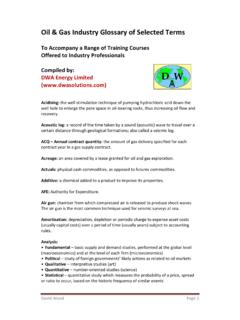Transcription of Cost and Performance Comparison of Stationary ... - NREL
1 Cost and Performance Comparison Of Stationary Hydrogen Fueling Appliances Duane B. Myers, Gregory D. Ariff, Brian D. James, John S. Lettow, (Sandy) Thomas, & Reed C. Kuhn One Virginia Square 3601 Wilson Boulevard, Suite 650 Arlington, Virginia 22201 703/243-3383 ABSTRACT This work was funded by the Hydrogen Program Office of the Department of Energy under Grant No. DE-FG01-99EE35099 and represents the second task of three to be completed under this contract. The first task presented a broad overview of the costs for creating infrastructures to supply direct hydrogen, methanol, and gasoline to support fuel cell vehicles (FCV s).
2 A conclusion of the report resulting from the first task was that the costs of maintaining the existing gasoline infrastructure per vehicle supported are up to two times more expensive than the estimated costs of maintaining either a methanol or a hydrogen fuel infrastructure . The second task, as detailed in this report, was to provide a detailed analysis of the cost of providing small-scale Stationary hydrogen fueling appliances (HFA s) for the on-site production and storage of hydrogen from natural gas to fuel hydrogen FCV s. Four potential reforming systems were studied: 10-atmosphere steam methane reforming (SMR) with pressure-swing adsorption (PSA) as gas cleanup, 20-atm SMR with metal membrane gas cleanup, 10-atm autothermal reforming (ATR) with PSA gas cleanup, and 20-atm ATR with metal membrane gas cleanup.
3 The full report for this work is available in pdf format at 1 Proceedings of the 2002 DOE Hydrogen Program Review nrel /CP-610-32405 INTRODUCTION Over several studies, Directed Technologies, Inc. has analyzed the costs of representative hydrogen fueling appliances (HFA s) to supply hydrogen to direct-hydrogen powered fuel cell vehicles (FCV s) and the cost of hydrogen produced by these HFA s. In previous studies we evaluated the impact of fuel choice on FCV, the cost of other sizes and quantities of HFA s, and the infrastructure maintenance costs of various fuels.
4 In this study we analyze the costs for an intermediate production rate (250/year) of HFA s sized to support communities of 183 vehicles each (about one-eighth the size of the current average gasoline station, and suitable for refueling 20 vehicles per day). This small HFA is chosen to allow economical hydrogen production in the early years when there are low numbers of FCV s present in any geographical area. While the focus of this report is on the economics of hydrogen production at this small unit size, it is noted that significant hydrogen cost reductions can be achieved by scaling the HFA unit to a larger size.
5 This report concludes by estimating the cost of an eight-fold capacity HFA that results in a 45% reduction in the cost of hydrogen. COST ESTIMATION METHODOLOGY The cost estimation methodology employed in this report is based on the Design for Manufacture and Assembly (DFMA) techniques developed by Boothroyd and Dewhurst, described in Product Design for Manufacture and Assembly, 2nd edition (Marcel Dekker, Inc., 2002). The DFMA process has been formally adopted by the Ford Motor Company (among others) as a systematic means for the design and evaluation of cost-optimized components and systems.
6 These techniques are powerful and are flexible enough to incorporate historical cost data and manufacturing acumen that have been accumulated by Ford since the earliest days of the company. Directed Technologies has adapted and expanded the formal DFMA technique to include lessons from Ford and its own experience to develop a system of tools and methods for cost estimation of engineering designs. The DFMA approach used for this analysis provides a solid framework for the cost study and is the only fair method to compare the cost of potential HFA configurations. The cost of each system component includes the cost of material, manufacturing, assembly, and markup.
7 Markup refers to the additional cost percentage to account for general and administrative (G&A) expenses, material scrap, spending on research and development (R&D), overhead (OH), and profit. In this analysis, two levels of markup may be applied to each component of the final system (see Figure 1). The lower level represents the markup applied by a vendor who sells a manufactured component to the appliance manufacturer (the final assembler). The higher level is the markup applied by the appliance manufacturer. (The total markup on a component then depends on who performs the work: the vendor or the HFA manufacturer.)
8 The final resulting cost is thus actually a projected price to the appliance purchaser (fueling station owner). In addition, the projected cost of hydrogen to the consumer (potentially a FCV motorist) is provided in this report, with inclusion of operating expenses to the reformer purchaser. HFA DESIGN ASSUMPTIONS The HFA is composed of a reforming system (including the reformer, gas cleanup system, and peripheral components), a hydrogen compressor, storage tanks, and dispenser. For the baseline HFA, we compared the costs and efficiencies of two hydrogen-generation technologies (steam methane reforming and autothermal reforming) and two hydrogen purification technologies (pressure swing adsorption and metal membrane).
9 Autothermal reforming (ATR) 2 Proceedings of the 2002 DOE Hydrogen Program Review nrel /CP-610-32405 is generally considered the lower initial-cost option for hydrogen generation because of a simpler reactor design, and steam methane reforming (SMR) is generally the higher-efficiency option because of more complete methane conversion. The processing options chosen for this Comparison emphasize the relative strengths of each process, with the result that there are many other potential variations that involve tradeoffs between capital cost and efficiency. Category Markup up on Manufactured/Assembled Components Markup on Pass Through Components Profit 15% 5% OH 3% 3% G&A 7% 3% R&D 4% 2% Scrap
10 2% 2% Total 31% 15% Figure 1. HFA Manufacturer Markup Rates The basic processing steps are common to both SMR and ATR: 1. Natural gas compression 2. Natural gas purification ( , sulfur removal) 3. Catalytic steam reforming of methane to hydrogen and carbon monoxide (CO) 4. Water-gas shift to convert carbon monoxide (CO) to carbon dioxide (CO2) and additional hydrogen 5. Hydrogen gas purification The difference between SMR and ATR is how heat is provided to activate the endothermic steam reforming reaction.













